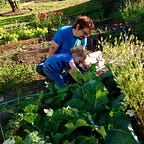Stinging Nettle Flavor Bomb
ALAS! Seattle springtime is already almost over (weather-wise, anyhow). Our local flora has responded to the unusually (for now) warm temperatures by maturing more quickly. Talk to people who notice such things, and they’ll tell you that for the past couple of years, “early arrival, quick maturity, early departure” seems to be the modus operandi in the local urban plant community. There’s something to be said for the larger picture here, about reassessing natural cycles and seasons, remodeling the wheel of the year and seasonal ceremonies, questioning our definitions of “natives” and “invasives” as horticultural climate refugees make their ways into our biospheres….
But let’s leave that for now and talk about something fun: how to take those early season flavors and keep them around for a while!
At the moment, it’s still quite possible to head out to your local foraging spot and find a plethora of delicious, young stinging nettles (Urtica dioica).
Now, I’m the kind of guy who will figure out a way to eat nettles at any stage in their life cycle. That said, there’s definitely something to the flavor of the early nettle shoots, the spring babies who peak out from the forest floor while the air remains cool and before the elders start to fruit.
Young nettles have a very unique and distinct flavor, unlike many other wild greens. They’re exceptionally versatile, delicious steamed, sauteed, in sauces, pestos, dips, or incorporated into baked goods and pasta. Once you’ve tried them, you’ll never want to go back, and although older nettles can still be eaten for a while (until they seed, according to some, when they can damage frail kidneys), you’ll find yourself longing for the flavor of the young ‘uns.
So, how to extend the flavor season for young nettles? Some people blanch, then freeze, but space in my freezer is limited. One can also dry and keep in an airtight container — this is perfectly acceptable. But, in the interest of maximizing both flavor and space, I’ve developed a way to preserve young nettle essence in a concentrated form using the magic of agar agar.
Agar agar, a jelly-like substance derived from algae, has been used as a gelatin-like food in Asian cultures for hundreds of years, typically to make fruity desserts. It can be found in most Asian markets, or in trendy western “health food stores,” or ordered online. It’s usually available as a powder, or flaked, or in bricks. The kind I get looks like this:
This stuff is fantastic, because, like gelatin, it causes liquids into which it is incorporated to firm when cooled, and it does so really quickly. It’s essentially flavorless by itself, and so it’s a fantastic medium for capturing flavors and keeping them around for later (in the late summer, I’ll share my salal/oregon grape agar jelly recipe, too!).
With nettles, salt (for flavor and as a preservative), water, and agar, you can capture the essence of early spring nettles and create a substance that can be used as a soup or broth base, or added to anything savory you’re cooking for an extra explosion of nettle goodness.
Stinging Nettle Flavor Bomb
A note on the recipe: since you never know how much nettle you may find, the instructions will be proportional instead of by specific amount.
Ingredients:
- Stinging nettles
- Water (1 cup per cup of nettles)
- Salt
- Agar (powdered or bricked)
- Any other deliciousness you’d like to include
Instructions:
- Add approximately one cup of water per cup of nettles to a pot, and bring to a boil. When water is boiling, add nettles for approximately three minutes.
- Remove nettles and retain water in pot.
- The nettles should no longer be sting-y. Remove woody stems and chop coarsely.
- Return nettles to the water. Bring back to a boil, then reduce to a simmer. Cover, and let simmer for 20–30 minutes, until water is dark green.
- Pulverize agar if not already powdered (a coffee grinder works well, but ripping it up seems to work just fine, too). I use about 0.25 oz per cup of water. It’s ok to play around with the ratio; more agar results in a more solid final product.
- Add the agar plus salt, about 1 tsp per cup of liquid, to the nettle mixture. (At this point, you can also add other delicious ingredients if you’re looking to create a bouillon or insta-soup. Pepper, garlic, onion , bay leaves— whatever your palate fancies.)
- Stir, then let simmer an additional ten minutes oruntil agar is completely dissolved.
- Remove from heat and put into a container. Place in fridge. After a few hours, depending on how much agar you used, you should have something that’s the consistency of a jelly, or even a solid brick. If it’s not solid enough for you, reheat and dissolve more agar into the mix.
And that’s it! The final product is a super-concentrated nettle explosion. The agar and salt will preserve it, refrigerated, for a couple of months.
Use it sparingly in savory dishes. Add a tablespoon to a mug of hot water for a yummy nettle broth. Toss a spoonful into the cooker next time you make rice for extra nettle oomph. This little flavor bomb trick will satisfy your spring nettle flavor yearning and amaze your friends!
